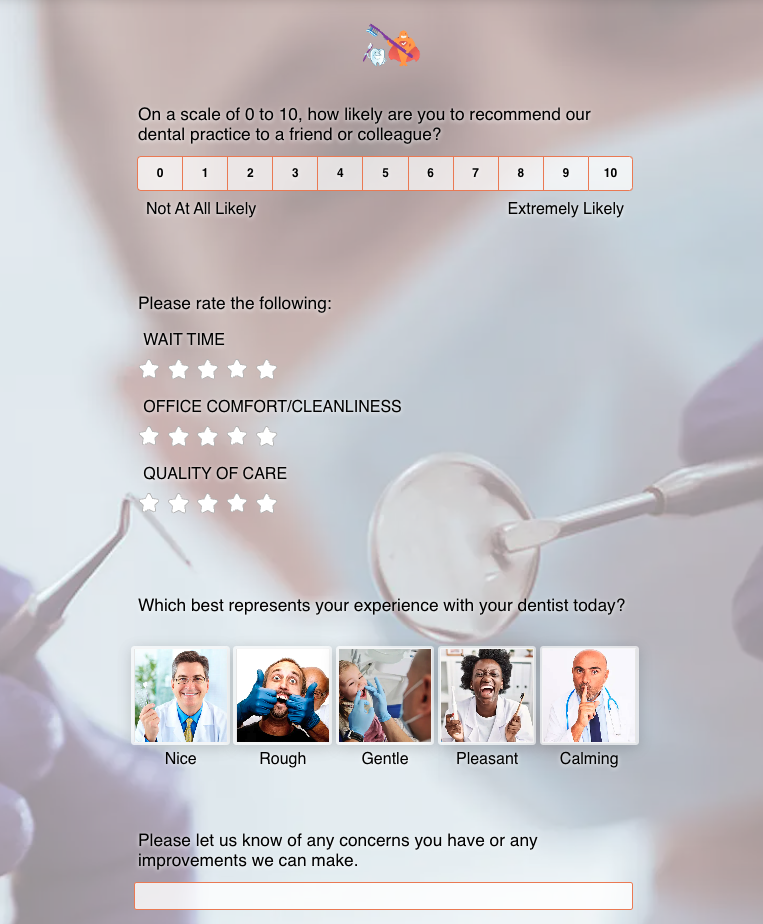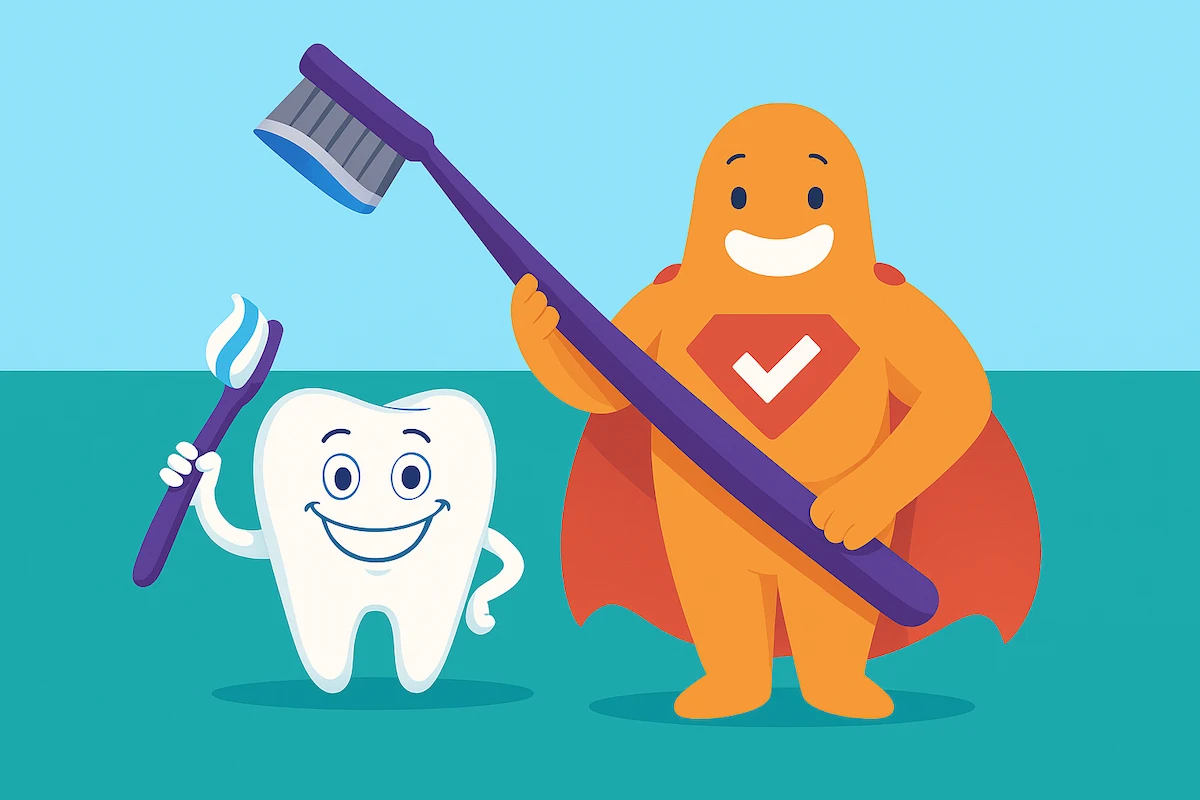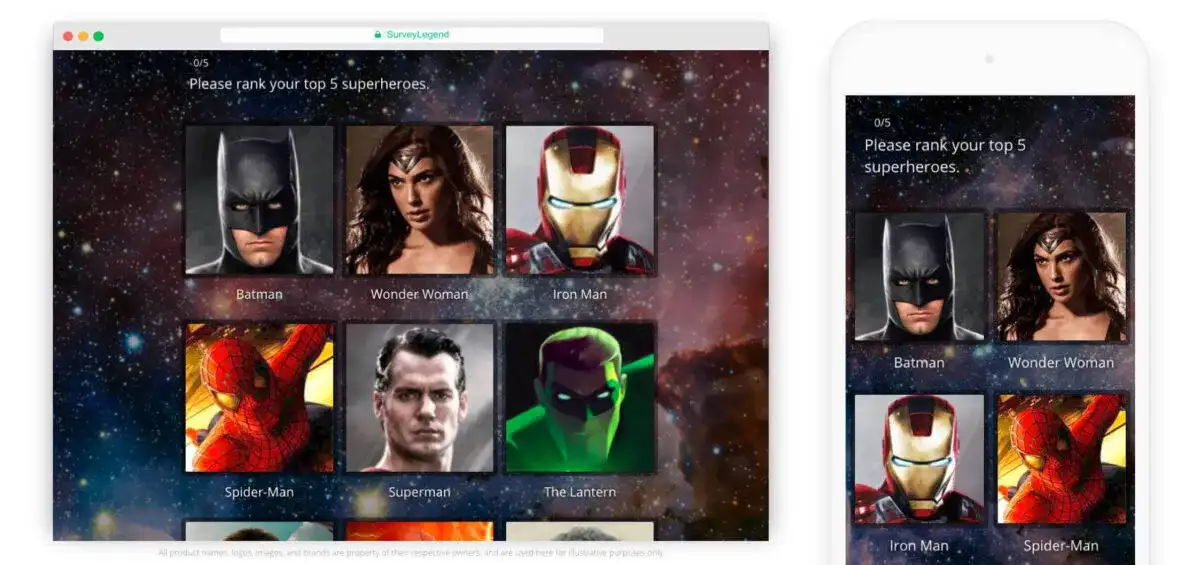Dental surveys help practices improve patient satisfaction, strengthen loyalty, and enhance care quality. By gathering feedback through kiosks, email surveys, QR codes, SMS texts, and mobile apps, dentists gain insights into patient experiences, staff performance, and service needs. The Net Promoter Score (NPS) is the most important survey question, revealing how likely patients are to recommend the practice and highlighting overall loyalty. Survey feedback supports quality improvement, reputation management, and compliance requirements. By analyzing patient responses, dental offices can identify trends, address concerns, refine services, and build long-term patient relationships.
Create Your FREE Dental Survey or Questionnaire Now!
The dentist-patient relationship can be… complicated. On one hand, everyone knows it’s important to keep their teeth well-maintained. On the other hand, sitting in a chair while someone puts their fingers and other equipment in your mouth can be a bit uncomfortable! Obtaining patient feedback is essential for improving dental care, as it helps practices understand patient needs and expectations.
To build trust and ensure high levels of care, patient satisfaction, and better health outcomes, dental surveys can be very useful for any practice. These surveys not only benefit individual patients but also provide valuable insights for the healthcare organization as a whole, helping to enhance service quality and reputation.
Create Your FREE Dental Survey or Questionnaire Now!
7 Benefits of Dental Surveys
Surveys help dentists’ offices collect feedback from patients. Collecting patient feedback and gathering feedback at various touchpoints along the patient journey are essential for understanding patient needs and improving the quality of care. This information can be used to improve services, enhance patient satisfaction, and address any concerns or issues. Here are some reasons why dental offices should consider using surveys:
- Patient Satisfaction: Surveys can help gauge how satisfied patients are with the overall level of care they receive. Collecting patient experience feedback and understanding patient sentiment are crucial for identifying areas to improve patient satisfaction. Surveys can then drill down from there, looking at staff performance, concerns, and so on.
- Quality Improvement: Feedback from surveys can reveal specific areas where the dental practice might need to make changes, such as appointment scheduling, wait times, communication, or the comfort of the office environment. Using actionable insights from patient feedback helps drive quality improvement and enhance patient safety.
- Patient Retention: A dental questionnaire for patients provides valuable feedback and can lead to the practice making necessary adjustments to increase patient loyalty and retention, leading to long-term relationships and a stronger patient base. Gathering patient feedback and fostering patient engagement are key strategies to improve patient retention.
- Staff Performance: Surveys can provide insights into how patients perceive the professionalism, friendliness, and competence of the dental office staff, including the dentist, hygienists, and administrative personnel. Reviewing patient feedback helps understand patient perceptions and the impact on the quality of care.
- Service Development: Patient feedback can help dental offices determine services that patients would like to see offered, allowing the practice to grow or refine its offerings to better meet patient needs. Gathering feedback along the patient journey can also help identify new health services to offer.
- Reputation Management: Positive feedback can be used in marketing efforts (real patient testimonials, once they’ve signed a release, are especially helpful for bringing in new patients). Of course, constructive criticism is also helpful. This allows the practice to address issues before they lead to negative reviews or word-of-mouth. Positive patient engagement and practice growth are supported by online reviews and patient feedback.
- Compliance and Accreditation: Some accreditation bodies or insurance companies may require dental practices to conduct patient satisfaction surveys as part of their quality assurance processes. Practice management software can play a role in collecting and analyzing patient data for compliance.
Create Your FREE Dental Survey or Questionnaire Now!
Collecting and analyzing patient data can improve patient outcomes and patient care by providing actionable insights that inform continuous improvement efforts.
NPS: The Most Important Question on a Dental Survey
How patient surveys are designed and implemented can play a crucial role in measuring patient satisfaction and identifying areas for improvement in dental practices.
Dental surveys should ask a variety of questions. However, there is one question that should be included on each patient survey: the Net Promoter Score (NPS). This is a widely used metric that measures customer loyalty and satisfaction by asking a simple question:
On a scale of 0 to 10, how likely are you to recommend our dental practice to a friend or colleague?
By analyzing NPS responses, dental practices can gain valuable insights into the entire patient journey, helping to pinpoint strengths and areas needing attention throughout every step of the patient experience.
Based on responses, patients are categorized into three groups:
- Promoters (9–10): Enthusiastic and likely to recommend the office or dentist.
- Passives (7–8): Satisfied but not overly enthusiastic.
- Detractors (0–6): Unhappy and may discourage others from using the practice or dentist.
Create Your FREE Dental Survey or Questionnaire Now!
The Net Promoter Score (NPS) is calculated by subtracting the percentage of Detractors from the percentage of Promoters. This results in a score that can range from -100 to +100. A high NPS indicates a strong base of loyal patients who are likely to drive positive word-of-mouth and contribute to the practice’s success. Additionally, a high NPS often reflects more positive patient interactions and can lead to improved patient outcomes, as satisfied patients are more engaged and likely to follow care recommendations. Conversely, a low NPS suggests that there are issues with patient satisfaction that need to be addressed.
With -100 being the lowest possible score, and 100 being the highest, you wouldn’t be wrong to assume that the benchmark for a “good” score is around 50. However, in a real-world setting, it is not so black and white. The average NPS for the health industry is 27, and the dental industry is even lower at an average of 1. Now, while that may seem very poor, remember, it is still positive. Anything above zero shows that the practice has more promoters than detractors.
Create Your FREE Dental Survey or Questionnaire Now!
Of course, it’s important to always try to increase your NPS. This can be done by listening to what patients say and making improvements. Also, focus on doing better with passives. They could easily become promoters. On the other hand, detractors are most likely a lost cause.
Check out all of our NPS articles here for more.
Create Your FREE Dental Survey or Questionnaire Now!
Types of Dental Surveys
Here’s a look at some of the most common types of dental patient surveys used by dental offices. These survey types help dental offices gather feedback and collect real-time patient feedback, allowing them to promptly address concerns and improve patient satisfaction. Many practices now use a secure patient portal to gather patient feedback, sending personalized messages post-appointment with links to surveys or review sites. This approach streamlines the process of gathering patient feedback and ensures responses are collected efficiently and confidentially.
Kiosk Survey
These surveys are conducted on a computer screen or tablet at the dental office. They are designed to be user-friendly and often feature simple, touch-screen interfaces with straightforward questions. Kiosk surveys are great for those in the medical field as they provide immediate feedback following an experience like a dental procedure or an interaction with the dentist and staff, capturing both patient sentiment and patient experience feedback right after the visit.
Create Your FREE Dental Survey or Questionnaire Now!
Because the surveys are conducted on-site, they often result in higher response rates and more accurate data since they collect responses while the experience or interaction is still fresh in the respondent’s mind, which makes their judgment more trustworthy. Read how to create your own kiosk survey here.
Patient Satisfaction Email Surveys
Email surveys are another great way to collect patient feedback, although the responses won’t be as immediate as with a kiosk survey (however, patients may be willing to get more in-depth with their answers since they will be taking these surveys at a later time, often from the comfort of their own home). Email surveys can also encourage honest feedback and more detailed responses about the patient’s experience, as patients may feel more comfortable sharing candid thoughts in a private setting.
Create Your FREE Dental Survey or Questionnaire Now!
Another good thing about email surveys is that you can easily see who did or did not open the survey and make improvements to it for a future send to increase response rates. You can also A/B test subject lines, imagery, and so on to see which is more effective. SurveyLegend offers dozens of different types of online survey questions, which we explore in our blog 12 Different Types of Survey Questions and When to Use Them (with Examples).
QR Code Survey
The QR Code has made a big comeback since the pandemic. Now, they are used to immediately bring information to any user’s phone simply by scanning it. This is a great option for offices that don’t want to invest in a kiosk: They can simply create a QR Code that, when scanned, will pull up the survey on a patient’s phone. QR codes can also direct patients to online review platforms, making it easier for them to leave feedback and helping to attract prospective patients by enhancing your online reputation. Read more about the benefits of QR code surveys.
Create Your FREE Dental Survey or Questionnaire Now!
SMS Text Surveys
Many people rarely use their phones to talk anymore, and ignore calls from unknown numbers! This makes SMS (Short Messaging Service) texting a great way to conduct dental patient surveys. SMS surveys are delivered via text to patients who have opted in to receive notifications from the sender. This means that there is usually some level of engagement, improving response rates. SMS surveys can reach many patients quickly and efficiently, making it easier to gather feedback from more patients and grow your practice.
The one downside is that questions typically need to be short, and answers are generally 1-2 words or simply numbers (this is why many NPS surveys, gauging customer satisfaction, are often conducted via SMS text). Be careful not to send too many text surveys, as a patient can opt out just as easily, usually by texting STOP.
Create Your FREE Dental Survey or Questionnaire Now!
Mobile App Surveys
Last but not least, many dental practices use mobile app surveys. Of course, they must have an app of their own, but many do for scheduling, prescriptions, messaging, and so on. Mobile app surveys can be an ideal way to conduct surveys, as people have to willingly download your app; this means they already have a level of engagement with your practice, making them more likely to respond to your surveys. Mobile app surveys also allow dental practices to collect patient data, which can be used to better treat patients by tracking their feedback and improving ongoing care.
Analyzing Patient Feedback Data
Analyzing patient feedback data is essential for any dental practice aiming to deliver outstanding healthcare services and boost patient satisfaction. With so many ways to collect feedback—whether through patient satisfaction surveys, online reviews, or mobile app surveys—dental offices have access to a wealth of information about patient experiences and perceptions of care quality.
By carefully reviewing patient feedback data, healthcare providers can uncover valuable insights into how patients perceive their entire journey, from scheduling appointments to receiving treatment and follow-up care. This analysis helps identify patterns and trends, such as recurring compliments or concerns, which can highlight both strengths and areas needing improvement within the practice.
Create Your FREE Dental Survey or Questionnaire Now!
For example, patient satisfaction surveys might reveal that patients appreciate the friendliness of the staff but would like shorter wait times. Online reviews can provide real-time feedback and immediate reactions, offering a candid look at what patients value most—or what might be causing frustration. Mobile app surveys, meanwhile, can capture feedback from engaged patients who are already interacting with your practice digitally.
Ultimately, analyzing feedback data empowers healthcare providers to make data-driven decisions that enhance patient experiences, improve service quality, and drive continuous improvement. By acting on these insights, dental practices can foster greater patient loyalty, attract new patients, and ensure that every patient receives the highest standard of care.
Create Your FREE Dental Survey or Questionnaire Now!
Dental Survey Example
Here is a simple example of a dental survey questionnaire you can create with SurveyLegend. Our surveys allow you to use a variety of types of questions (starting with the all-important NPS). You can include questions that encourage patients to leave an online review and provide both positive and negative feedback about their experience. Reviewing patient feedback is essential for identifying areas of improvement and enhancing your services.
You can add branding, choose background imagery and font, and so much more. Our surveys can be delivered via email, used on kiosks, attached to mobile apps, text messages, or QR codes, and more. They’re secure, fun to create, and user-friendly for your patients!

Conclusion
Using surveys, dental practices can gain valuable insights into patient satisfaction, identify areas for improvement, and enhance the overall patient experience. Dental surveys help drive quality improvement by providing actionable feedback that supports the patient’s well-being, especially through post-procedure follow-ups and ongoing care. Surveys also help in identifying trends and potential issues early, including even negative feedback, which should be addressed promptly to foster trust and continuous improvement. This allows the practice to make data-driven decisions that improve care quality and operational efficiency. SurveyLegend can help! Our surveys are easy to create and easy for participants to take. Get started today for free!
Does your dental practice use patient surveys? What types of dental health survey questions do you ask? Could SurveyLegend benefit your practice? Let us know in the comments!
Create Your FREE Dental Survey or Questionnaire Now!
Frequently Asked Questions
How often should dental practices survey patients?
The frequency of surveying patients in a dental practice will vary, especially based on the survey method (e.g., kiosks can allow people to participate every time they visit). However, most practices that conduct surveys do them after each visit, after staff changes, or after specific procedures.
What is a dental fear survey?
A dental fear survey assesses a patient’s level of anxiety or fear related to dental visits and procedures. These surveys are designed to identify specific sources of fear, which could stem from bad or painful experiences in the past, embarrassment over poor dental hygiene/worry about being judged, concerns over sedation, anxiety over restraint or tools, etc.. Dentists may be able to use the responses to assure patients that they are gentle, sedation is safe, the practice is a judgment-free zone, and so on.



